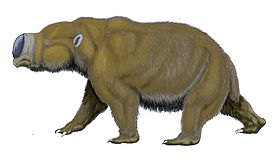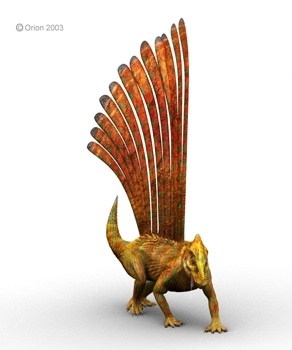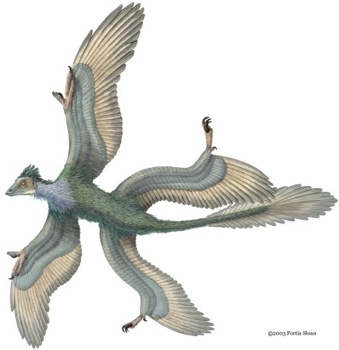1. Deinocheirus
The only fossils found from this dinosaur is a pair of arms and some parts of the spine. Possible Deinocheirus are relatives of ornithomimosaur, at least that's the assumption by paleontologists.

He is a genus of large theropod dinosaur that lived in the late Cretaceous period and the population spread in southern Mongolia. His arms may be too long for the body and the claw hand it indicates that he is one of the deadly dinosaurs.
But in fact, the usefulness of the "arms" is still widely debated. Some researchers said the claw was used as the main tool for hunting.
Several others said the claws were too blunt, so it is only used as a defensive weapon. There is even a suggestion that Deinocheirus using large arms to climb trees, although this hypothesis is widely ignored.
2. Diprotodon
Before the first man to set foot on the continent of Australia about 40,000 years ago, varied-sized marsupials once lived there. One of the largest is Diprotodon.

This one marsupial estimated size of an adult Hippos. Judging from the shape morphology, it looks much like a Wombat, the Australian marsupial species, but huge.
Just like most other marsupial animals, Diprotodon also consume leaves as its main food. Although they are not animals like kangaroos have nimble movements, but the size of a large and powerful body make it very difficult for predators to defeated.
3. MOROPUS
When scientists find fossils Moropus for the first time, they seemed hard to believe morphology of this one creature. Ancient animal with a head like a horse's head actually has a weird body shape.

Scientists describe it as a "mix" of three animals, namely horses, pygmy giraffes and bears. Horse-like head and the body of a bear-like bodies connected by a rather long neck like a giraffe's neck dwarf.
With long nails sharp nan, and the ability to run well of course he has a good defense to avoid the threat of predators. Moropus living in the southern and western Asia about 12,000 years ago.
4. Ambulocetus
This is one of the many ancient creatures claimed adherents of Neo-Darwinism as strong evidence of a transition period species of sea creatures to land. Ambulocetus, ancient animals with a mixture similar stature ancestors of whales and otters living in what is now known as modern Pakistan about 50 million years ago.

Ambulotecetus an adult body length is estimated about 12 feet. Form a large head with a long jaw. The teeth are designed to capture sharp and gripping prey. In the water, he can move with nimble thanks to the help of his tail is used as a "motor" for the body.
5. Lystrosaurus
Before the emergence of dinosaurs, living creature on Earth ever enlivened by some strange animal-like reptiles. One is Lystrosaurus.

Ancient animals is quite interesting because of the shape of her life in this strange swampy habitat, but it also does not matter if it should be forced to inhabit the places classified as dry. Lystrosaurus expected to inhabit the Earth about 230 million years ago.
6. PHORUSRHACOS
About 20 million years ago, South America is a land that has so many variations of species of birds and mammals. One of them is fairly well known carnivorous bird species named Phorusrhacos.

He is a species of bird that can not fly. Height can reach 10 feet (3 meters). Although not able to fly, they are fast runners. This makes Phorusrhacos can easily catch their prey.
Phorusrhacos species estimated to exist up to 3 million years ago. Scientists estimate Phorusrhacos extinction caused by the emergence of several other predators are migrating from North to South Amrika after the two connected by a land which appears to the Central American mainland.
7. Mammoth
I'm sure you guys are familiar with this one legendary animal. Mammoth is one of the ancient animals that are so popular. Physically resembling the elephant but has a thick fur all over its body.
Great stature and an additional "arms" of ivory so long makes it so difficult to conquer any predators. The paintings are the scratched on cave walls by early man many describe how difficult this animal to be conquered by them.
Mammoth is the animals that inhabit the surrounding Wrangel Island in the northern coast of Siberia. Many scientists believe that the last generation of Mammoth still can be found around 4000 years ago during construction of Khufu pyramid in Giza, Egypt have been completed.
8. TIGER TOOTH SWORD
They are one of the ice-age animals are so well known. One of the most vicious predator nan deadliest ever set foot on this earth. Tiger Tooth Sword inhabit the western United States at the end of the ice age, but they are also scattered in several other regions of North America and some lived in the South American region.

Known, there are two genus of animal, namely Genus Genus Smilodon and Homotherium. In general, the type of the genus Smilidon long fangs can reach more than 18 centimeters, while the long fangs Homotherium genus of about 10 centimeters. These animals hunt horses, bison, antelope for food.
9. DEINOTHERIUM
Deinotherium is one of the largest land mammals that ever set foot on Earth. Prehistoric creatures that lived at a time when the middle Miocene to early Pleistocene in general has a high 3.5 to 4.5 meters (Deinotherium sized adult) and weighing between 5-14 tons.

Deinotherium which are close relatives of modern elephants live in ancient times spread over many parts of Asia, Africa, and Europe. Physical form is not much different from modern elephants, except that it has a shorter snout and tusks are located on the lower jaw.
Ivory may be used as a tool to dig the ground to gain access to the roots and vegetables. Deinotherium genus has three species have been identified, and all have a large size. Species diataranya Deinotherium giganteus, Deinotherium indicum, and Deinotherium bozasi.
10. THERIZINOSAURIDAE
Therizinosauridae is saurischians, theropods, dinosaurs of the families who lived in the late Cretaceous period (99.6 - 65.5 million years ago). Unlike most saurischians, theropods, which are carnivores, herbivores Therizinosauridae is (although some of them are known as omnivores).

It should be underlined, Therizinosauridae is the name of a familia in scientific classification. This name was first used by Evgeny Maleev in 1954 to include Therizinosaurus cheloniformis (Type saurischians, theropods, which still has a lot of puzzles) into a familia along with Segnosaurus and Nothronychus.
Family Therizinosauridae physical form of an eccentric. By and large they have fur and a long neck. Besides their claws are also quite large, there may be more than one meter in length.
11. EPIDEXIPTERYX
Epidexipteryx is a small genus of dinosaur maniraptorian. Prehistoric animals that live in the region of China around 152-168 million years ago, this is one of the smallest dinosaurs ever.

Adult size of only 10 inches (about the size of a pigeon). One attraction of Epidexipteryx is growing four long feathers on the tail.
Unlike feathers that we usually encounter in class aves animals, feather structure on Epidexipteryx is just like a sheet of tape that stands extends upward. However, due to lack of remiges (wing feathers) makes this animal can not fly.
12. Longisquama insignis
Living in the mid to late Triassic period (230-225 million years ago), Longisquama insignis an ancient lizard is so interesting because it has a series of "fur" that stands along the length of his back.
The structure of "feather" until now is still a matter of debate among researchers. Some researchers believe that the term structure that grows on the backs Longisquama not the kind of fur, but scales can generally be found in reptiles such as iguanas.

The difference scales on Lingisquama longer and shaped a bit awkward. However, in the opinion of paleontologists, N. Frasher in his Dawn of the Dinosaurs: Life in the Triassic, elongated structure is not a part of his body.
This structure is likely similar to ferns that come with fossil and then misinterpreted. Opinions Frasher may be strengthened by the fact fossilized structures found in some animals it often has nothing to do with fossil animals.
13. SHAROVIPTERYX
Sharovipteryx a contemporary living reptiles Longisquama, ie, in the mid to late Triassic. Ancient creatures that have a body length of about eight inches with a weight of 7.5 grams is very unique because it has the size of a very large hind legs than front legs.
The hind legs are so wide, coupled with the membrane that grows them make it as if it had wings with which to fly. Despite the fact that these animals are not able to fly like a bird, but by no means a stretch of the wing membrane on its feet it becomes useless.

Recent research thanks to the wing membrane, the Sharovipteryx be more agile when sliding from one place to another due to its mechanism of action is very similar to the delta wing in modern fighter aircraft.
Some researchers believe the animals may have a close relationship with pterosaurs remember the They shared a flight membrane growing between his legs, although it is still very controversial.
14. Pterodaustro
Pterodaustro has a very long skull, which is about 29 cm. Snout dominates 85% of the total length of the skull. Another oddity is the physical form of an unusual set of teeth.

Teeth that grow lower jaw like thousands of fur seal that may he used as a tool to filter out plankton, algae, and other small makhkluk of water.
Teeth that grow in the thousands two long grooves parallel to the edge of the jaw. About 3 cm in length with a width between 0.2 - 0, 3 millimeters. Initially thought this structure was not teeth, but after some research allegations eventually fade. The structure is really a normal tooth as there are enamel, dentin and pulp.
15. Microraptor
The genus Microraptor is one line of small dinosaurs. They lived about 120 million years ago and the population is spread out in several parts of China. This type generally has four wings with an elongated tail.
Despite having two pairs of wings, Microraptor could not fly. Instead, he may just glide from one place to another like a flying squirrel.

Some evolutionists assume the animal is a creature of dinosaur to bird transition, where the ability meluncurnya it can grow into the aviation system.
Some researchers argue, it is likely that many animals spend their lives in trees, referring to the fact that the wings of Microraptor hinder their ability to walk on land.
16. Amphicoelias fragillimus
Elusive fossil was discovered by famed paleontologist Edward Drinker Cope. Cope has found many prehistoric fossils, but this one is the most bizarre.

How could I not? only one piece is strange fossil vertebrae which has long keseluruahan estimated 40-60 meters. If this measure is completely valid, it makes Amphicoelias fragillimus is probably the longest and heaviest creatures ever (to compete with the blue whale and the Argentinosaurus).
But again, the fossil is still much debate as to the difficulty of identifying fossil discoveries are very, very minimal. Is this creature is the largest animals to ever walk the earth, or whether only the misunderstandings and just hoax.

0 comments:
Post a Comment